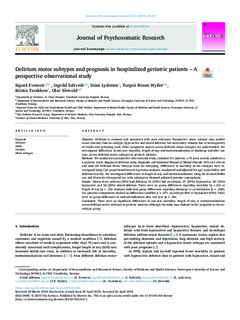| dc.contributor.author | Evensen, Sigurd | |
| dc.contributor.author | Saltvedt, Ingvild | |
| dc.contributor.author | Lydersen, Stian | |
| dc.contributor.author | Wyller, Torgeir Bruun | |
| dc.contributor.author | Taraldsen, Kristin | |
| dc.contributor.author | Sletvold, Olav | |
| dc.date.accessioned | 2019-09-02T13:35:44Z | |
| dc.date.available | 2019-09-02T13:35:44Z | |
| dc.date.created | 2019-06-20T10:33:11Z | |
| dc.date.issued | 2019 | |
| dc.identifier.citation | Journal of Psychosomatic Research. 2019, 122 24-28. | nb_NO |
| dc.identifier.issn | 0022-3999 | |
| dc.identifier.uri | http://hdl.handle.net/11250/2612075 | |
| dc.description.abstract | Objective
Delirium is common and associated with poor outcomes. Hypoactive motor subtype may predict worse outcome than no-subtype, hyperactive and mixed delirium, but uncertainty remains due to heterogeneity of results and subtyping tools. Other prognostic aspects across delirium motor subtypes are understudied. We investigated differences in one-year mortality, length of stay and institutionalization at discharge and after one year, across delirium motor subtypes in geriatric patients.
Methods
We conducted a prospective observational study, included 311 patients ≥75 years acutely admitted to a geriatric ward, diagnosed delirium using Diagnostic and Statistical Manual of Mental Disorder (5th ed.) criteria and used the Delirium Motor Subtype Scale for subtyping. Differences in mortality across subtypes were investigated using Cox proportional-hazard regression analyses, unadjusted and adjusted for age, comorbidity and delirium severity. We investigated differences in length of stay and institutionalization using the Kruskal-Wallis test and Pearson's chi-squared test with subsequent Hommel-adjusted pairwise comparisons.
Results
Ninety-three patients (30%) had delirium; 12 (13%) had no-subtype, 27 (29%) hyperactive, 30 (32%) hypoactive and 24 (26%) mixed delirium. There were no group differences regarding mortality (p = .61) or length of stay (p = .32). Analyses indicated group differences regarding discharge to an institution (p = .028), but pairwise comparisons showed no differences (smallest p = .071, no-subtype 45% vs hypoactive 85%). There were no group differences in institutionalization after one year (p = .26).
Conclusion
There were no significant differences in one-year mortality, length of stay or institutionalization across delirium motor subtypes in geriatric patients, although the study may indicate better prognosis in the no-subtype group. | nb_NO |
| dc.language.iso | eng | nb_NO |
| dc.publisher | Elsevier | nb_NO |
| dc.rights | Attribution-NonCommercial-NoDerivatives 4.0 Internasjonal | * |
| dc.rights.uri | http://creativecommons.org/licenses/by-nc-nd/4.0/deed.no | * |
| dc.title | Delirium motor subtypes and prognosis in hospitalized geriatric patients – A prospective observational study | nb_NO |
| dc.type | Journal article | nb_NO |
| dc.type | Peer reviewed | nb_NO |
| dc.description.version | publishedVersion | nb_NO |
| dc.source.pagenumber | 24-28 | nb_NO |
| dc.source.volume | 122 | nb_NO |
| dc.source.journal | Journal of Psychosomatic Research | nb_NO |
| dc.identifier.doi | 10.1016/j.jpsychores.2019.04.020 | |
| dc.identifier.cristin | 1706342 | |
| dc.description.localcode | © 2019 The Authors. Published by Elsevier Inc. This is an open access article under the CC BY-NC-ND license (http://creativecommons.org/licenses/BY-NC-ND/4.0/) | nb_NO |
| cristin.unitcode | 194,65,30,0 | |
| cristin.unitcode | 1920,15,0,0 | |
| cristin.unitcode | 194,65,35,5 | |
| cristin.unitname | Institutt for nevromedisin og bevegelsesvitenskap | |
| cristin.unitname | Medisinsk klinikk | |
| cristin.unitname | RKBU Midt-Norge - Regionalt kunnskapssenter for barn og unge - psykisk helse og barnevern | |
| cristin.ispublished | true | |
| cristin.fulltext | original | |
| cristin.qualitycode | 1 | |

